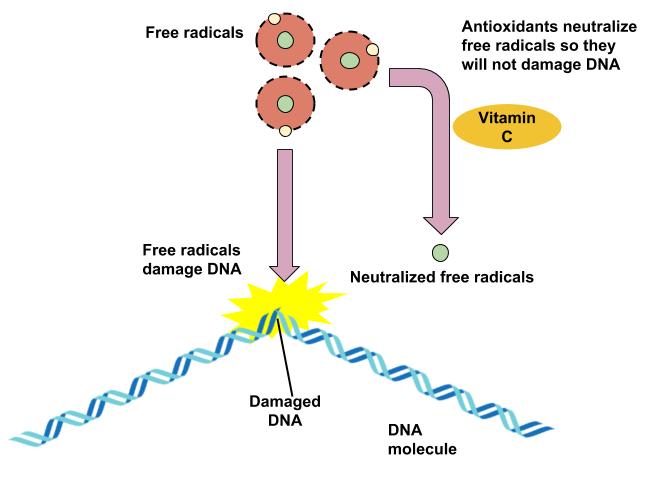Chapter 11. Micronutrients as Antioxidants
Antioxidants
Learning Objectives
- Define free radicals and discuss how they can damage cells
- Describe antioxidants and how they interact with and neutralize free radicals to prevent cell damage.
- Describe the roles of the “big three” vitamin antioxidants (A,C, and E)
- Identify foods high in antioxidant know common dietary sources of Vitamins A, C, and E.
-
Describe the relationship between the 3 key vitamin antioxidants and disease
The market is flooded with advertisements for “super antioxidant” supplements teeming with molecules that block free radical production, stimulate the immune system, prevent cancer, and reduce the signs of aging. The general public believes these health claims because of the success of the antioxidant supplement industry. However, these claims are not backed by scientific evidence; rather, there is some evidence suggesting supplements can actually cause harm. While scientists have found evidence supporting the consumption of antioxidant-rich foods as a method of reducing the risk of chronic disease, there is no “miracle cure”; no pill or supplement alone can provide the same benefits as a healthy diet. Remember, it is the combination of antioxidants and other nutrients in healthy foods that is beneficial. In this section, we will review how particular antioxidants function in the body, learn how they work together to protect the body against free radicals, and explore the best nutrient-rich dietary sources of antioxidants. One dietary source of antioxidants is vitamins. In our discussion of antioxidant vitamins, we will focus on vitamins E, C, and A.

What are Antioxidants and Free Radicals?
Antioxidants are compounds that prevent oxidation by interacting with and neutralizing free radicals. Thus antioxidants can protect cells from any damage caused by oxidation. But what is oxidation and what is a free radical?
Oxidation is a chemical reaction in which atoms lose electrons, whereas reduction is when atoms gain electrons. Stable atoms have an even number of electrons orbiting in pairs in their outer shell. When an atom loses an electron during oxidation, typically, reduction will occur to stabilize the unpaired electron. However, in some cases, the electrons remain unpaired and these highly reactive molecules are known as free radicals. The body naturally produces free radicals, but environmental factors such as air pollution, excessive sunlight, tobacco smoke, asbestos, and radiation can all increase free radical production. When there is an imbalance of free radical production with the ability of our bodies to neutralize them, cell damage and oxidative stress occur. The cell membrane is one of the most significant sites of free radical damage. Free radicals also play a major part in the development of diseases autoimmune disorders, cardiovascular disease such as heart disease, neurodegenerative disease (e.g., Alzheimer’s and Parkinson’s disease), cataracts, various cancers[1] and diabetes[2].
Antioxidants work by donating an electron to a free radical to stabilize the unpaired electron, and thus reduce the potential damage by excessive free radicals.
Antioxidant Chemicals Obtained from the Diet
There are many different antioxidants in food, including selenium, which is one of the major antioxidants. However, the antioxidants you may be the most familiar with are vitamins. The “big three” vitamin antioxidants are vitamins A, C, and E. However, they may be called the “big three” only because they are the most studied.
| Antioxidant | Functions Attributed to Antioxidant Capacity |
| Vitamin E | Protects cellular membranes, prevents glutathione depletion |
| Vitamin C | Protects DNA, RNA, proteins, and lipids, aids in regenerating vitamin E |
| Vitamin A | Protects cellular membranes, prevents glutathione depletion, maintains free radical detoxifying enzyme systems, reduces inflammation |
| Carotenoids | Free radical scavengers |
| Lipoic acid | Free radical scavenger, aids in regeneration of vitamins C and E |
| Phenolic acids | Free radical scavengers, protect cellular membranes |
- Pham-Huy et al., 2008. Free Radicals, Antioxidants in Disease and Health Int J Biomed Sci . Jun;4(2):89–96. https://pmc.ncbi.nlm.nih.gov/articles/PMC3614697/ ↵
- Bhatti et al., 2022. Oxidative stress in the pathophysiology of type 2 diabetes and related complications: Current therapeutics strategies and future perspectives. Free Radic Biol Med. May 1:184:114-134. doi: 10.1016/j.freeradbiomed.2022.03.019. Epub 2022 Apr 7. https://pubmed.ncbi.nlm.nih.gov/35398495/ ↵

